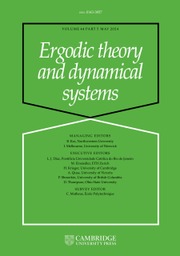Crossref Citations
This article has been cited by the following publications. This list is generated based on data provided by
Crossref.
Sarnak, P.
1982.
Entropy estimates for geodesic flows.
Ergodic Theory and Dynamical Systems,
Vol. 2,
Issue. 3-4,
p.
513.
Freire, A.
and
Ma��, R.
1982.
On the entropy of the geodesic flow in manifolds without conjugate points.
Inventiones Mathematicae,
Vol. 69,
Issue. 3,
p.
375.
Osserman, R.
and
Sarnak, P.
1984.
A new curvature invariant and entropy of geodesic flows.
Inventiones Mathematicae,
Vol. 77,
Issue. 3,
p.
455.
Burns, K.
Katok, A.
Ballman, W.
Brin, M.
Eberlein, P.
and
Osserman, R.
1985.
Manifolds with non-positive curvature.
Ergodic Theory and Dynamical Systems,
Vol. 5,
Issue. 2,
p.
307.
Ballmann, Werner
1986.
Curvature and Topology of Riemannian Manifolds.
Vol. 1201,
Issue. ,
p.
1.
Ledrappier, F.
1988.
Ergodic properties of Brownian motion on covers of compact negatively-curve manifolds.
Boletim da Sociedade Brasileira de Matemática,
Vol. 19,
Issue. 1,
p.
115.
1988.
Four applications of conformal equivalence to geometry and dynamics.
Ergodic Theory and Dynamical Systems,
Vol. 8,
Issue. 8,
p.
139.
Petkov, Vesselin M.
and
Stojanov, Luchezar N.
1988.
On the number of periodic reflecting rays in generic domains.
Ergodic Theory and Dynamical Systems,
Vol. 8,
Issue. 1,
p.
81.
Kanai, Masahiko
1988.
Geodesic flows of negatively curved manifolds with smooth stable and unstable foliations.
Ergodic Theory and Dynamical Systems,
Vol. 8,
Issue. 2,
p.
215.
de la Llave, R.
and
Moriyón, R.
1988.
Invariants for smooth conjugacy of hyperbolic dynamical systems. IV.
Communications in Mathematical Physics,
Vol. 116,
Issue. 2,
p.
185.
Stojanov, Luchezar
1989.
An estimate from above of the number of periodic orbits for semi-dispersed billiards.
Communications in Mathematical Physics,
Vol. 124,
Issue. 2,
p.
217.
Hurder, S.
and
Katok, A.
1990.
Differentiability, rigidity and Godbillon-Vey classes for Anosov flows.
Publications mathématiques de l'IHÉS,
Vol. 72,
Issue. 1,
p.
5.
Ledrappier, F.
1990.
Harmonic measures and bowen-margulis measures.
Israel Journal of Mathematics,
Vol. 71,
Issue. 3,
p.
275.
Babenko, I. K.
1990.
Volume rigidity of two-dimensional manifolds.
Mathematical Notes of the Academy of Sciences of the USSR,
Vol. 48,
Issue. 1,
p.
629.
Katok, Anatole
Knieper, Gerhard
and
Weiss, Howard
1991.
Formulas for the derivative and critical points of topological entropy for Anosov and geodesic flows.
Communications in Mathematical Physics,
Vol. 138,
Issue. 1,
p.
19.
Craig, Walter
1991.
Floquet exponents for Jacobi fields.
Ergodic Theory and Dynamical Systems,
Vol. 11,
Issue. 1,
p.
41.
Yue, Chengbo
1991.
Integral formulas for the Laplacian along the unstable foliation and applications to rigidity problems for manifolds of negative curvature.
Ergodic Theory and Dynamical Systems,
Vol. 11,
Issue. 4,
p.
803.
Ledrappier, François
1992.
Ergodic Theory and Related Topics III.
Vol. 1514,
Issue. ,
p.
131.
Hamenstädt, Ursula
1992.
Time-preserving conjugacies of geodesic flows.
Ergodic Theory and Dynamical Systems,
Vol. 12,
Issue. 1,
p.
67.
Hamenstädt, Ursula
1993.
Regularity of time-preserving conjugacies for contact Anosov flows withC1-Anosov splitting.
Ergodic Theory and Dynamical Systems,
Vol. 13,
Issue. 1,
p.
65.

